Answered step by step
Verified Expert Solution
Question
1 Approved Answer
Content Standard: PROBABILITY and MEASURES OF POSITION The learner demonstrates understanding of key concepts of probability and measures of position. Learning Objectives: The learners
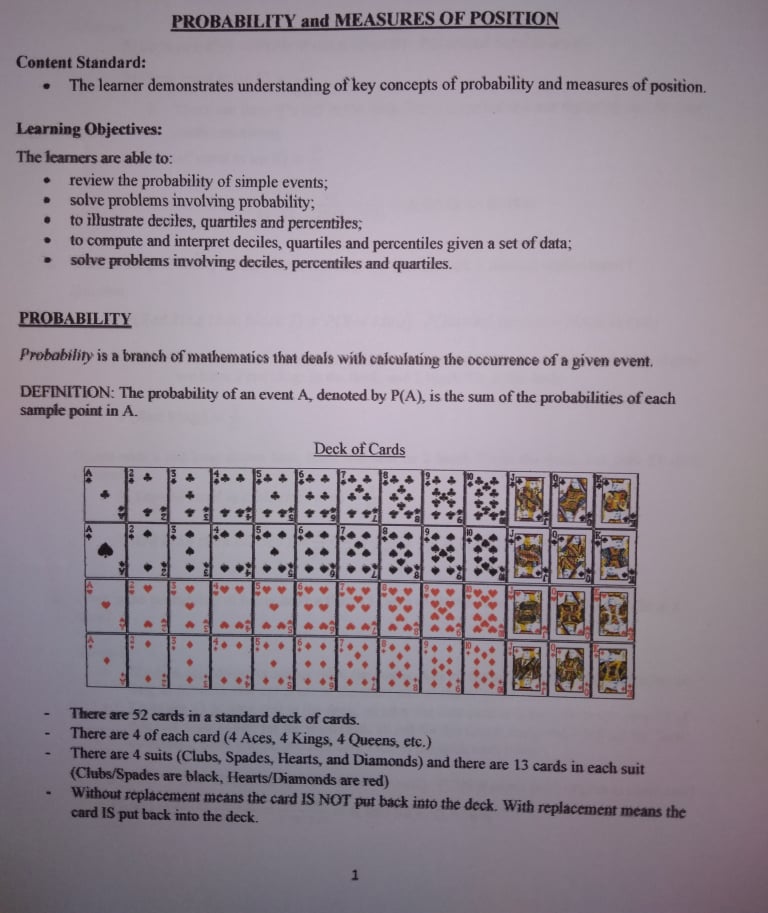
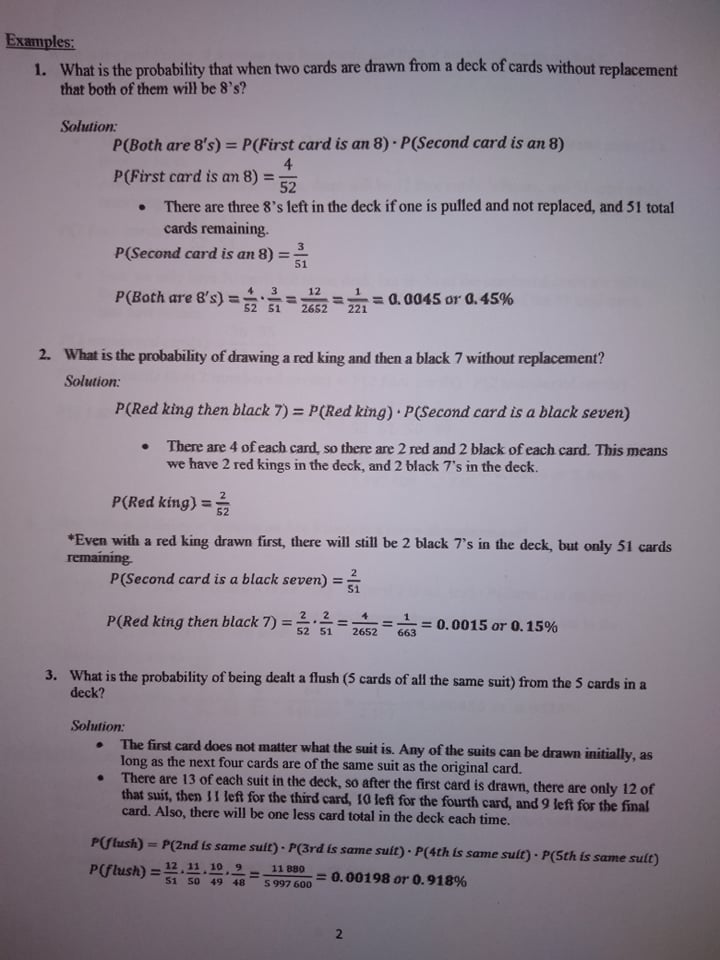
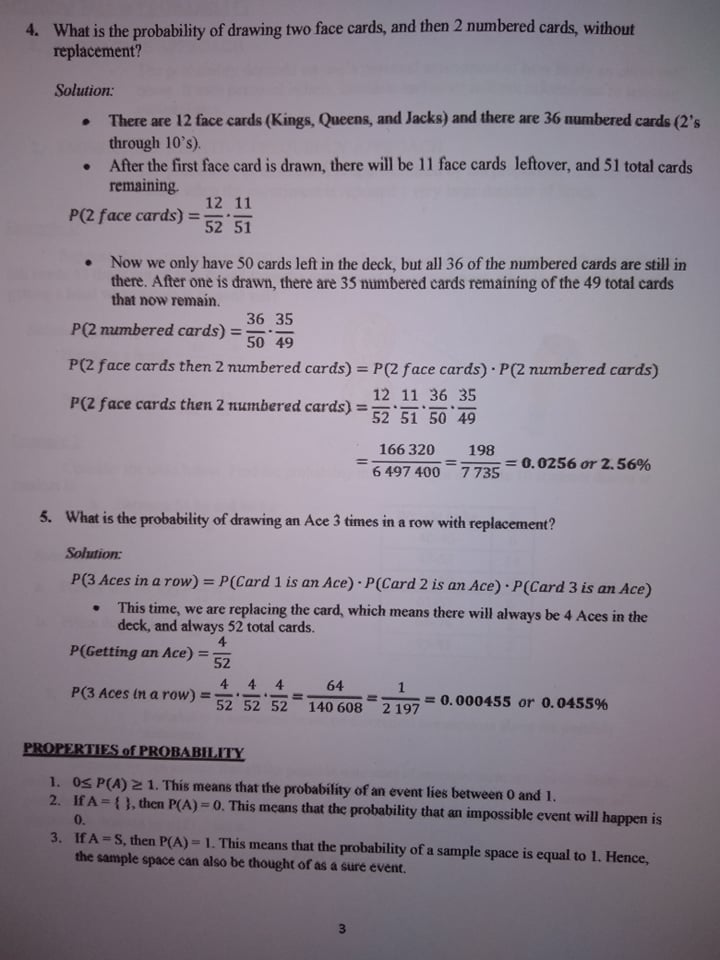
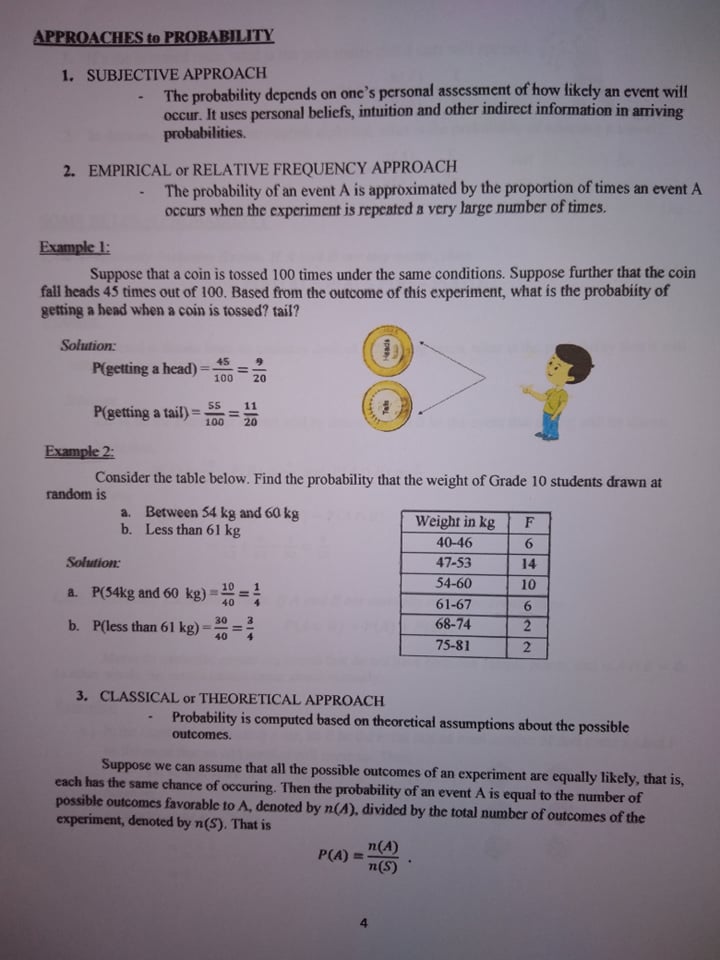
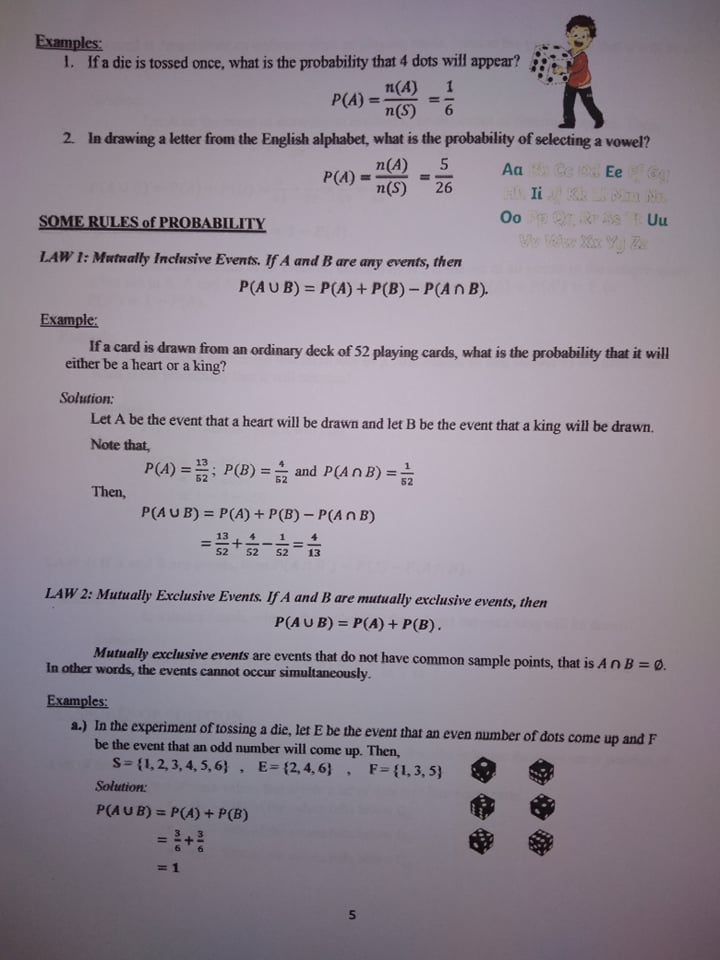
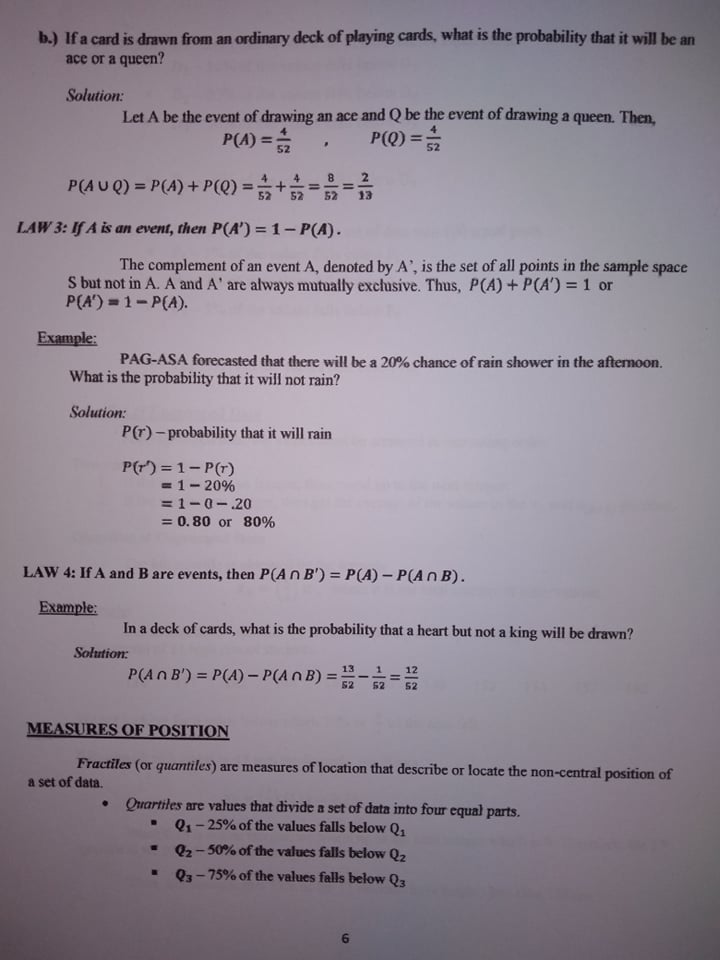
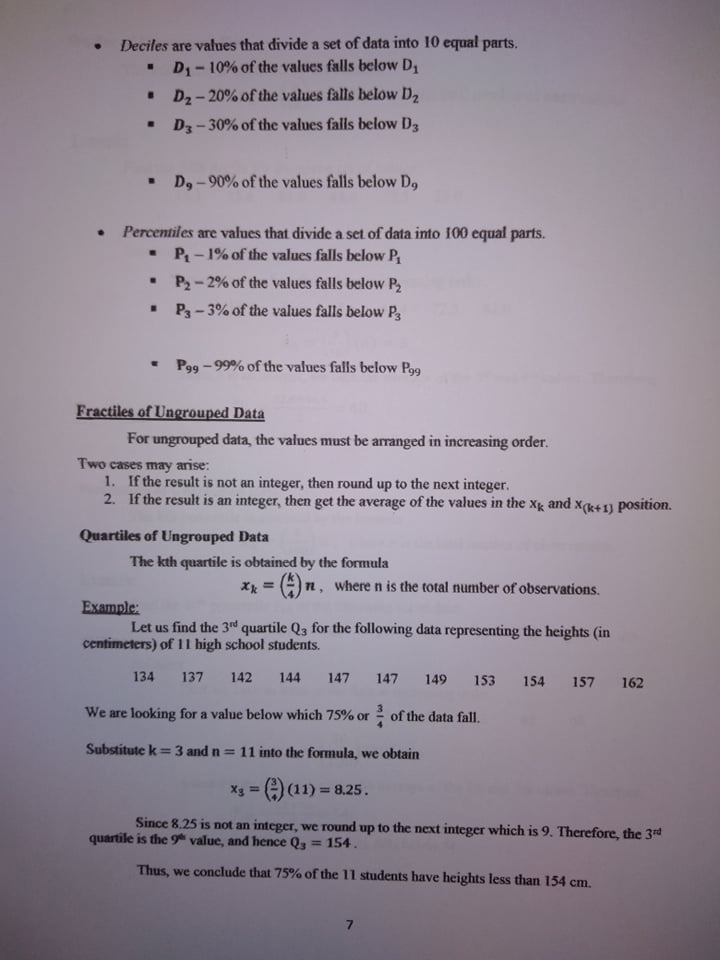

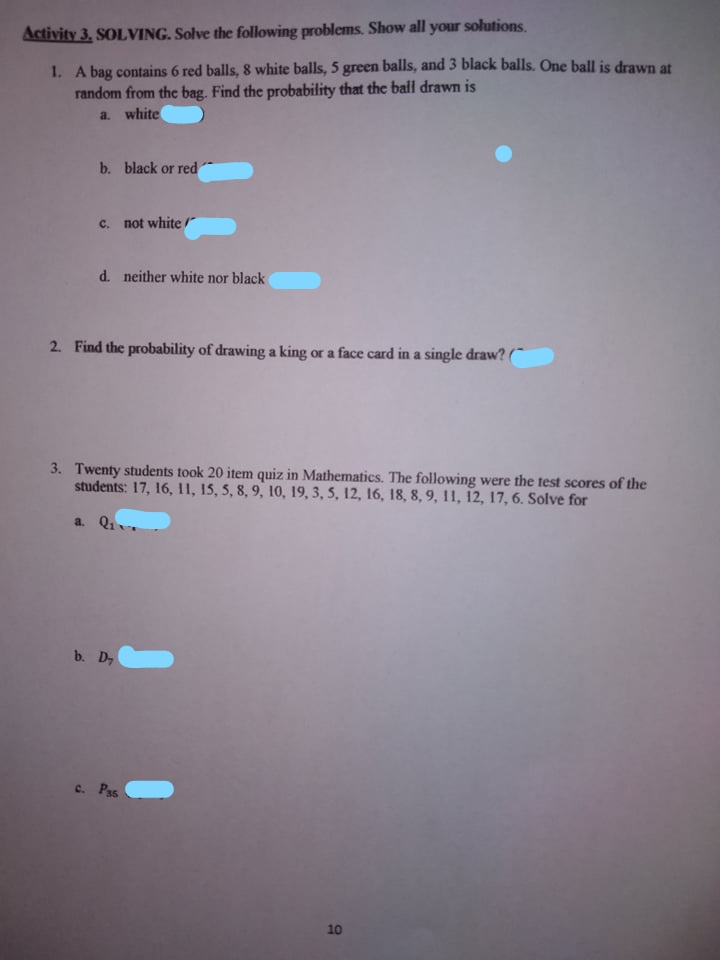

Content Standard: PROBABILITY and MEASURES OF POSITION The learner demonstrates understanding of key concepts of probability and measures of position. Learning Objectives: The learners are able to: review the probability of simple events; solve problems involving probability; to illustrate deciles, quartiles and percentiles; to compute and interpret deciles, quartiles and percentiles given a set of data; solve problems involving deciles, percentiles and quartiles. PROBABILITY Probability is a branch of mathematics that deals with calculating the occurrence of a given event. DEFINITION: The probability of an event A, denoted by P(A), is the sum of the probabilities of each sample point in A. Deck of Cards 4+ + 4 447 60 4 4 . 2010 No + Examples: 1. What is the probability that when two cards are drawn from a deck of cards without replacement that both of them will be 8's? Solution: P(Both are 8's) = P(First card is an 8) P(Second card is an 8) P(First card is an 8)=- 4 52 There are three 8's left in the deck if one is pulled and not replaced, and 51 total cards remaining. P(Second card is an 8): = 3 51 P(Both are 8's) = 3 12 . = =0.0045 or 0.45% 2652 221 2. What is the probability of drawing a red king and then a black 7 without replacement? Solution: P(Red king then black 7) = P(Red king) P(Second card is a black seven) There are 4 of each card, so there are 2 red and 2 black of each card. This means we have 2 red kings in the deck, and 2 black 7's in the deck. P(Red king) = 52 *Even with a red king drawn first, there will still be 2 black 7's in the deck, but only 51 cards remaining P(Second card is a black seven) = 51 P(Red king then black 7) = =0.0015 or 0.15% 52 51 2652 663 3. What is the probability of being dealt a flush (5 cards of all the same suit) from the 5 cards in a deck? Solution: The first card does not matter what the suit is. Any of the suits can be drawn initially, as long as the next four cards are of the same suit as the original card. There are 13 of each suit in the deck, so after the first card is drawn, there are only 12 of that suit, then II left for the third card, 10 left for the fourth card, and 9 left for the final card. Also, there will be one less card total in the deck each time. 100 P(flush) = P(2nd is same suit)- P(3rd is same suit) P(4th is same sult) P(5th is same sult) P(flush): = 9 12.11. 12 11 10 11 880 = 51 50 49 48 5 997 600 = 0.00198 or 0.918% 2 4. What is the probability of drawing two face cards, and then 2 numbered cards, without replacement? Solution: . There are 12 face cards (Kings, Queens, and Jacks) and there are 36 numbered cards (2's through 10's). After the first face card is drawn, there will be 11 face cards leftover, and 51 total cards remaining. P(2 face cards) = 12 11 52 51 Now we only have 50 cards left in the deck, but all 36 of the numbered cards are still in there. After one is drawn, there are 35 numbered cards remaining of the 49 total cards that now remain. P(2 numbered cards) = 36 35 50 49 . P(2 face cards then 2 numbered cards) = P(2 face cards) P(2 numbered cards) 12 11 36 35 . P(2 face cards then 2 numbered cards) = 52 51 50 49 166 320 198 = 6 497 400 7735 =0.0256 or 2.56% 5. What is the probability of drawing an Ace 3 times in a row with replacement? Solution: P(3 Aces in a row) = P(Card 1 is an Ace) P(Card 2 is an Ace) P(Card 3 is an Ace) . This time, we are replacing the card, which means there will always be 4 Aces in the deck, and always 52 total cards. 4 P(Getting an Ace) = P(3 Aces in a row) = 52 64 . = 52 52 52 140 608 = 0.000455 or 0.0455% 2 197 PROPERTIES of PROBABILITY 1. 0 P(A) 1. This means that the probability of an event lies between 0 and 1. 2. If A= {}, then P(A)=0. This means that the probability that an impossible event will happen is 0. 3. If A-S, then P(A)=1. This means that the probability of a sample space is equal to 1. Hence, the sample space can also be thought of as a sure event. APPROACHES to PROBABILITY 1. SUBJECTIVE APPROACH The probability depends on one's personal assessment of how likely an event will occur. It uses personal beliefs, intuition and other indirect information in arriving probabilities. 2. EMPIRICAL or RELATIVE FREQUENCY APPROACH Example 1: The probability of an event A is approximated by the proportion of times an event A occurs when the experiment is repeated a very large number of times. Suppose that a coin is tossed 100 times under the same conditions. Suppose further that the coin fall heads 45 times out of 100. Based from the outcome of this experiment, what is the probability of getting a head when a coin is tossed? tail? Solution: 45 P(getting a head)= = = 100 20 55 11 P(getting a tail)= = 100 20 FORD Example 2: Consider the table below. Find the probability that the weight of Grade 10 students drawn at random is a. Between 54 kg and 60 kg b. Less than 61 kg Solution: a. P(54kg and 60 kg)== 40 b. P(less than 61 kg): 30 40 Weight in kg F 40-46 6 47-53 14 54-60 10 61-67 68-74 75-81 622 3. CLASSICAL or THEORETICAL APPROACH Probability is computed based on theoretical assumptions about the possible outcomes. Suppose we can assume that all the possible outcomes of an experiment are equally likely, that is, each has the same chance of occuring. Then the probability of an event A is equal to the number of possible outcomes favorable to A, denoted by n(A), divided by the total number of outcomes of the experiment, denoted by n(S). That is P(A)= n(A) n(S) Examples: 1. If a die is tossed once, what is the probability that 4 dots will appear? P(A)= n(A) 1 n(S) 6 =- 2. In drawing a letter from the English alphabet, what is the probability of selecting a vowel? SOME RULES of PROBABILITY P(A)= n(A) n(S) == 52 Aath Ce Dd Ee 26 Oo Uu Wr Wbe Xxx Yy Za LAW 1: Mutually Inclusive Events. If A and B are any events, then Example: P(AUB) = P(A) + P(B)-P(An B). If a card is drawn from an ordinary deck of 52 playing cards, what is the probability that it will either be a heart or a king? Solution: Let A be the event that a heart will be drawn and let B be the event that a king will be drawn. Note that, Then, P(A) = P(B) = and P(ANB) = 52 P(AUB) = P(A) + P(B) = P(ANB) = 52 52 LAW 2: Mutually Exclusive Events. If A and B are mutually exclusive events, then P(AUB) = P(A) + P(B). Mutually exclusive events are events that do not have common sample points, that is An B=0. In other words, the events cannot occur simultaneously. Examples: a.) In the experiment of tossing a die, let E be the event that an even number of dots come up and F be the event that an odd number will come up. Then, S={1,2,3,4,5,6}, E= {2,4,6) F={1,3,5) Solution: P(AUB) = P(A) + P(B) 9 =1 5 b.) If a card is drawn from an ordinary deck of playing cards, what is the probability that it will be an ace or a queen? Solution: Let A be the event of drawing an ace and Q be the event of drawing a queen. Then, P(Q) = P(A)= ' P(AUQ) = P(A) + P(Q) =+== LAW 3: If A is an event, then P(A') = 1-P(A). The complement of an event A, denoted by A', is the set of all points in the sample space S but not in A. A and A' are always mutually exclusive. Thus, P(A) + P(A) = 1 or P(A) 1-P(A). Example: PAG-ASA forecasted that there will be a 20% chance of rain shower in the afternoon. What is the probability that it will not rain? Solution: P(r) probability that it will rain P(r)=1-P(r) = 1-20% =1-0-20 = 0.80 or 80% LAW 4: If A and B are events, then P(An B') = P(A)-P(ANB). Example: In a deck of cards, what is the probability that a heart but not a king will be drawn? Solution: 22 P(An B') = P(A)-P(ANB) = 11-1=12 MEASURES OF POSITION 13 52 52 52 Fractiles (or quantiles) are measures of location that describe or locate the non-central position of a set of data. Quartiles are values that divide a set of data into four equal parts. Q1-25% of the values falls below Q Q2-50% of the values falls below Q2 Q3-75% of the values falls below Q3 Deciles are values that divide a set of data into 10 equal parts. D-10% of the values falls below D D-20% of the values falls below D " D3-30% of the values falls below D3 D,-90% of the values falls below Do .Percentiles are values that divide a set of data into 100 equal parts. " P-1% of the values falls below P P2-2% of the values falls below P " P3-3% of the values falls below P3 P99-99% of the values falls below P99 Fractiles of Ungrouped Data For ungrouped data, the values must be arranged in increasing order. Two cases may arise: 1. If the result is not an integer, then round up to the next integer. 2. If the result is an integer, then get the average of the values in the X and X(k+1) position. Quartiles of Ungrouped Data The kth quartile is obtained by the formula Example: x=(4) n 7, where n is the total number of observations. Let us find the 3rd quartile Q3 for the following data representing the heights (in centimeters) of 11 high school students. 134 137 142 144 147 147 149 153 154 157 162 We are looking for a value below which 75% or of the data fall. Substitute k=3 and n = 11 into the formula, we obtain x3 = () (11) = 8.25. Since 8.25 is not an integer, we round up to the next integer which is 9. Therefore, the 3rd quartile is the 9 value, and hence Q = 154. Thus, we conclude that 75% of the 11 students have heights less than 154 cm. Deciles of Ungrouped Data The kth decile is obtained by the formula Example: x=()n, where n is the total number of observations. 10. Find the fifth decile for the given set of values: Solution: 18.1 35.6 81.0 44.4 72.5 25.0 Let us arrange first the values in increasing order. 18.1 25.0 35.6 44.4 72.5 81.0 x5 = () (6) = 3 Since 3 is an integer, we take the average of the 3 and 4 values. Therefore, D5 = 35.6+44.4 2 =40. This means that 50% of the data falls below 40. Percentiles of Ungrouped Data The kth percentile is obtained by the formula Example: xk x = (10) n, where n is the total number of observations. Find the 40 percentile P40 of the following set of data: 62 52 61 43 57 Solution: 68 39 56 41 65 First we have to arrange the data in increasing order. 39 41 43 52 56 57 61 62 65 68 40 X40 = (100) (10) = 4 Since 4 is an integer, we take the average of the 4th and 5th values. Therefore, P40 = 52+56 2 = 54. This means that 40% of the data falls below 54. Activity 3, SOLVING. Solve the following problems. Show all your solutions. 1. A bag contains 6 red balls, 8 white balls, 5 green balls, and 3 black balls. One ball is drawn at random from the bag. Find the probability that the ball drawn is a. white b. black or red c. not white/ d. neither white nor black 2. Find the probability of drawing a king or a face card in a single draw? ( 3. Twenty students took 20 item quiz in Mathematics. The following were the test scores of the students: 17, 16, 11, 15, 5, 8, 9, 10, 19, 3, 5, 12, 16, 18, 8, 9, 11, 12, 17, 6. Solve for a. Q b. D c. Pas 10 Activity 1. MATCHING TYPE. Match Column A with Column B. Write only the letter of the correct answer in the lines before the number. 1. If a die is rolled, then the probability of getting an even number is 2. The probability of a certain event. 3. The probability of a face card from red cards. 4. Three identical coins are tossed together, n(S) = ? 5. If P(A)=0.82, then P(A)=? 6. The probability of raining in a day. 7. A card is pulled from a deck of 52 cards. The probability of obtaining a club is 8. If the probability that it will rain tomorrow is 0.7. What is the probability that it will not rain? 9. In a class of 40 students, 25 are girls. What is the probability of selecting a boy? 10. There are two children in the family. Find the probability that There is at least one girl in the family. Activity 2. Candy Jar A. 1 B. 8 ARCD C. D. 10 E. F. G. H. 0.3 MI+ 4 32 13 14 I. 0.18 J. 0.28 K. 0.03 L. 0.1 M. 6 12 N. 152 1. What is the probability of picking an orange candy? 2. What is the probability of picking a yellow candy? 3. What is the probability of picking a blue candy? 4. What is the probability of picking a green candy? 5. Which candy is least likely to be picked at random? 9
Step by Step Solution
There are 3 Steps involved in it
Step: 1

Get Instant Access to Expert-Tailored Solutions
See step-by-step solutions with expert insights and AI powered tools for academic success
Step: 2

Step: 3

Ace Your Homework with AI
Get the answers you need in no time with our AI-driven, step-by-step assistance
Get Started


